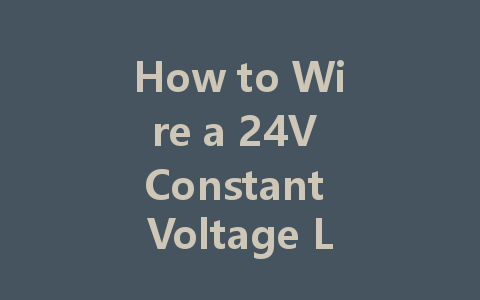Wiring a 24V constant voltage LED driver may seem intimidating, but understanding the process can help you achieve a successful installation. This guide will walk you through everything you need to know to wire your LED driver safely and effectively.
Understanding the Basics of a Constant Voltage LED Driver
Before diving into the wiring process, let’s clarify what a constant voltage LED driver is. This device provides a stable voltage output (in this case, 24V) to your LED lights, ensuring they operate efficiently while minimizing flickering and extending their lifespan. These drivers are commonly used for LED strips, outdoor lighting, and other low-voltage systems.
Tools and Materials Required
To get started, ensure you have the following tools and materials on hand:
Having everything ready will streamline the installation process and ensure that you don’t encounter interruptions.
Safety First: Precautions to Take
Safety should always be your top priority when working with electrical components. Here are some essential precautions to follow:
By following these precautions, you’ll minimize risks and create a safe working environment.
Steps to Wire Your 24V Constant Voltage LED Driver
Now that you understand the basics and have taken safety precautions, let’s move on to the actual wiring process.
Most 24V constant voltage LED drivers will have two sets of wires: input and output. The input wires connect to the power source, while the output wires lead to your LED lights. Make sure to distinguish between these two sets before proceeding.
Using your wire cutter/stripper, strip about half an inch of insulation off the input wires of your LED driver. Connect these wires to your power source’s wires, matching the positive (usually red) and negative (usually black) terminals. Secure the connections with wire nuts or electrical tape to ensure they are safe and reliable.
Next, it’s time to connect the output wires from the LED driver to the LED lights or strips. Strip the insulation from the output wires and connect them to your LED lights, ensuring you match the positive and negative terminals correctly. Again, use wire nuts or electrical tape for secure connections.
Before turning on the power, double-check all your connections to ensure they are correct and secure. This step is crucial; incorrect wiring could damage your LED driver or lighting components.
Testing Your Installation
Once everything is connected, it’s time to test your installation.
Turn the power source back on and examine whether the LED lights turn on. If they do, great job! If not, turn off the power again and carefully inspect your connections for any mistakes.
If the lights are not functioning, consider using a voltage meter to measure the output from the LED driver. Check that you are receiving a consistent 24V output. If not, there may be an issue with the driver itself or the wiring.
Troubleshooting Common Issues
Even with the best planning and execution, issues can arise during installation. Here are some common problems and their solutions:
결론
Wiring a 24V constant voltage LED driver is a straightforward process if you follow the necessary steps and safety precautions. With this guide, you should be able to successfully connect your driver to your LED lights, leading to a bright and efficient lighting solution. Don’t forget that practice makes perfect; if this is your first time, take your time and double-check each step. Happy wiring!
